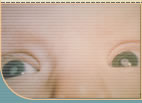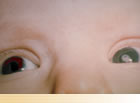
Contact Lens Information
Learning the Tips for Insertion and Removal
Silsoft and Soft Contact Lenses
Rigid Gas Permeable Contact Lenses
Getting Help:
• Benefit from the support and knowledge of your Clinical Coordinator, Study Physician, and Contact Lens Fitter who will teach you about insertion, removal, and care of your child's contact lens (CL).
• Keep phone numbers handy and make those phone calls for assistance.
• Keep an ongoing list of questions for future appointments and phone calls.
• Enhance your opportunity for a quality conversation by scheduling the appointment at your child's best time of the day.
You are not alone!
Learning the Tips for Inserting and Removing the Contact Lens:
• Seek information from your resources (study personnel, your physician, other parents, the IATS and other websites, the IATS Caregiver Resource Notebook, pamphlets, books).
• Realize that feeling comfortable when applying and removing the contact lens (CL) will come with practice. Through experience, you will acquire this skill just as you learned to change a diaper on your squirming baby.
• Give yourself enough time.
• Select a location where you will be able to find a dropped lens.
• Choose a quiet place; play music if this will relax you or your child.
• Wait after failed attempts; breath deeply, try again, persevere, and demonstrate patience.
• Ask someone to help you.
• Realize that there will be times when your child will not like having this done; newborns are annoyed but they will adapt; 6 to 9 month old infants may go through a period of resistance.
• Settle your child with a pacifier, bottle, favorite blanket or a special toy reserved for this time.
• Make a checklist of everything you are going to need and set out the items beforehand (ie. tissues, CL storage case, CL solutions, mirror, flashlight, etc.).
• Keep your nails short and smooth.
• Use a fragrance free soap to wash your hands.
• Check for CL damage before putting the lens into the eye.
• Learn where the CL edges rest in relation to the colored part of the eye (iris).
• Look at your child's eye periodically. The CL may not be in the correct position or even in the eye.
• Call the study coordinator or the CL fitter if the eye is red or your child keeps rubbing the eye and is crying more than usual.
• Make certain the CL is still in place before beginning steps to remove it.
You and your child will find your own way! You can do it!
Characteristics of Contact Lens Types
• Larger than rigid gas permeable (RGP) lens
• Cover slightly more than the colored part of the eye (iris)
• Move less on the eye than GP lenses
• Centers are more rigid than the rest of the lens
• Flexible, pliable and can be pinched into the shape of a taco
• Smaller than the Silsoft and Soft lenses
• Smaller than the colored part of the eye (iris)
• Moves more on the eye than Silsoft or soft lenses
• Stiff
• Should not be bent
• Suction cup may be used to remove the lens

Patching
#1 - FAQ's
#2 - TIPS
#3 - Practicalities
#4 Video
Glasses
#1 Guidelines
#2 Spectacles
Contact Lenses
#1Contact Lenses
#2Contacts Video
Diary
#1 Eye Care Diary
#2 Detailed Diary Instructions
#3 Diary Video
Tips for Visual Acuity Testing